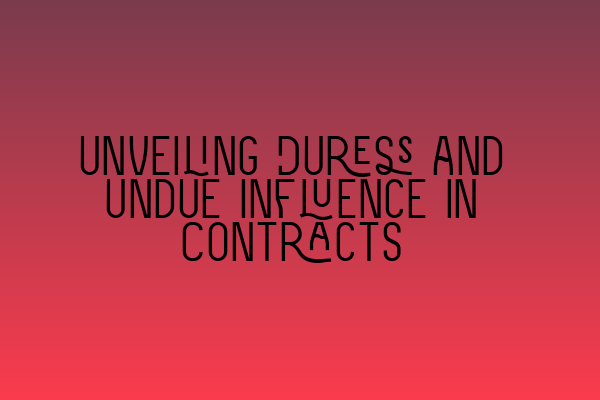Unveiling Duress and Undue Influence in Contracts
Contracts are the backbone of business transactions and dealings. They provide a framework within which parties can agree upon terms and conditions for the exchange of goods, services, or assets. However, in some cases, contracts may be entered into under dubious circumstances, where one party exerts undue pressure or influence over the other. This can result in contracts that are not truly voluntary and may be considered void or unenforceable due to duress or undue influence.
In this article, we will delve into the concepts of duress and undue influence in contracts, understanding what they mean and how they affect the validity of contractual agreements.
Defining Duress in Contracts
Duress refers to a situation where one party is coerced or forced into entering a contract against their will. It occurs when one party makes a threat or engages in conduct that deprives the other party of their free will and ability to exercise their judgment in entering into the contract.
The following are some common examples of duress in contracts:
- Physical threats or violence
- Blackmail or extortion
- Threats to damage a person’s reputation or business
- Economic pressure or financial hardship
When duress is established, the contract is considered voidable at the option of the coerced party. This means that the coerced party can choose to either uphold or reject the contract due to the wrongful influence exerted upon them.
Understanding Undue Influence
Undue influence occurs when one party takes advantage of a position of power or trust to manipulate the other party’s decisions and actions. It typically involves the exertion of persuasive tactics that overpower the free will of the influenced party and lead them to enter into a contract that they would not have agreed to otherwise.
Undue influence can be categorized into two types: actual undue influence and presumed undue influence.
Actual undue influence refers to situations where there is evidence of explicit manipulation, coercion, or persuasion that negates the influenced party’s free will. On the other hand, presumed undue influence is based on certain relationships or circumstances wherein the court presumes the existence of undue influence. Examples of relationships that often give rise to presumed undue influence include guardian and ward, solicitor, and client, and doctor and patient relationships.
When undue influence is proven, the contract is considered voidable, similar to duress. The influenced party can choose to either affirm or reject the contract, depending on the circumstances and their best interests.
The Implications of Duress and Undue Influence
The presence of duress or undue influence can have significant implications on the validity of a contract. If a contract is found to be tainted by duress or undue influence, it may be rendered void or unenforceable. This means that the affected party may be able to escape their obligations under the contract or seek remedies for any damages suffered.
However, it is essential to understand that proving duress or undue influence can be challenging. The burden of proof lies with the party alleging the presence of duress or undue influence, and it requires substantial evidence and legal arguments to establish such claims successfully.
Conclusion
Contracts are the foundation of business relationships, and it is crucial that they are entered into freely and voluntarily. The presence of duress or undue influence undermines the integrity of contracts by depriving parties of their autonomy, leading to agreements that may not genuinely reflect their intentions.
At SQE Contract Law, we believe in the importance of understanding the nuances of duress and undue influence. It is vital for both solicitors and clients to be aware of these concepts when drafting and entering into contracts to ensure fair and equitable agreements.
If you found this article helpful, you may also be interested in reading our related articles:
